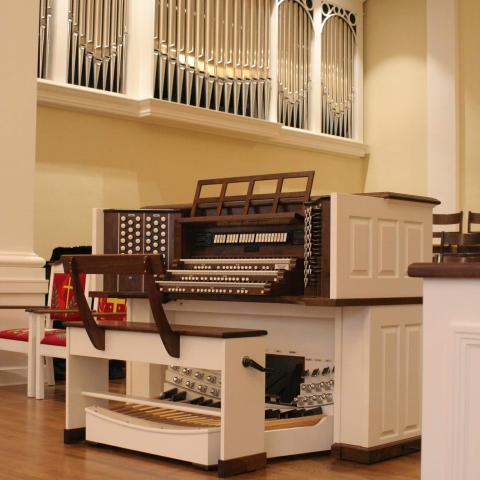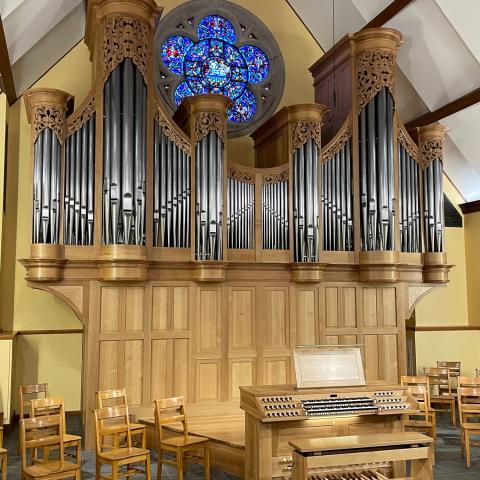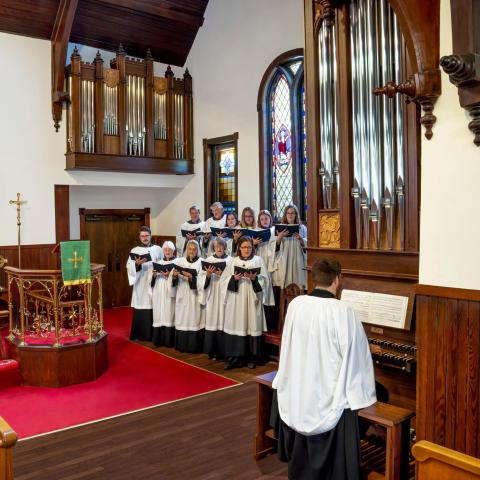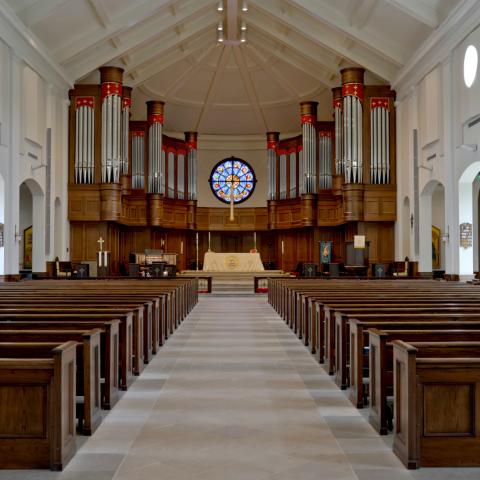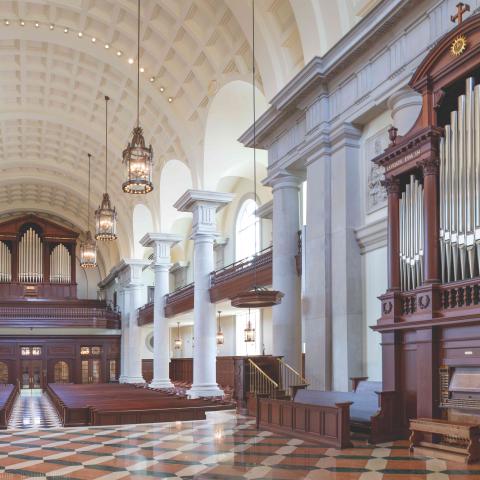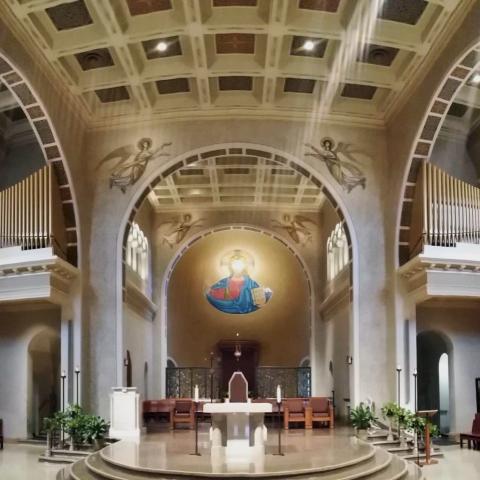C. B. Fisk, Inc., Gloucester, Massachusetts
First United Methodist Church, Pittsburg, Kansas
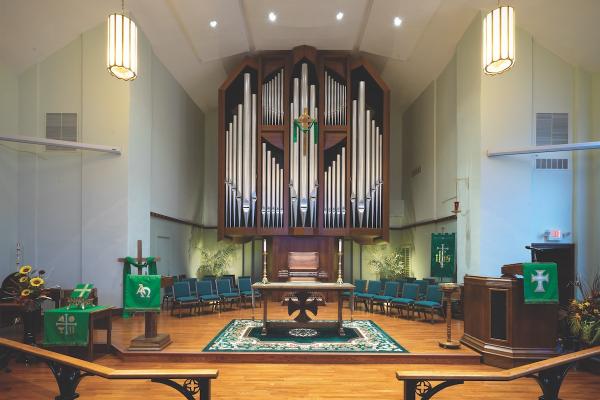
From the Organbuilder
Forever ago it seems, in the year 1991, C. B. Fisk, Inc., was commissioned to build a three-manual, 49-stop teaching and recital instrument in McCray Hall on the campus of Pittsburg State University, Pittsburg, Kansas. Our first organ in the Sunflower State, Opus 106 provided us an opportunity to work closely with PSU professor Susan Marchant, the school’s widely respected director of choral activities, organ, and harpsichord. Trained in organ performance at Oberlin and Yale, Dr. Marchant allowed at the time that, should the stars someday align again, her dream was to acquire a Fisk instrument for her church—the First United Methodist Church of Pittsburg.
Well, to the benefit of all, twenty-six years later the stars did indeed realign, and in the spring of 2017 C. B. Fisk was awarded a contract with FUMC to build a two-manual, 26-stop mechanical-action organ. Discussions had commenced the year previous with Dr. Marchant, music director and organist, Eric Rosenblad, chair of the organ committee, and the Reverend Mark Chambers, senior pastor. It was decided early on that Opus 152, in contrast to its predecessor, would be centrally located and facing forward at the front of the sanctuary, enabling it to speak without obstruction into the nave. Its unorthodox, imaginative tonal design, developed in close collaboration with the music director, would be efficient, flexible, and specific to the needs of a traditional United Methodist parish church with a reputable, first-rate music program. For our part, we were as delighted at the opportunity for further artistic partnership with Dr. Marchant as we were enthused to add to the collection of fine musical instruments that enhance life in southeastern Kansas.
The First United Methodist Church was established in 1879 as the Tabernacle Methodist Church, three years after the founding of the city of Pittsburg. The current building, a sturdy and nicely proportioned edifice of red brick, is the third in the church’s 140-year history. Dating from 1914, it stands at the intersection of 5th and Pine Streets, one block west of Pittsburg’s picturesque main street.
The church has recently undergone a major renovation, a new pipe organ having been a cardinal component of the renovation plan from day one. Acoustical consultant Joseph Myers, president of Kirkegaard Associates in Chicago, was key to the revitalization of the sanctuary design. Following a day of joint onsite listening and brainstorming with Fisk president Michael Kraft and project manager Andrew Gingery, and encompassing ideas that came out of visual designer Charles Nazarian’s initial studies in the physical design model, Mr. Myers generated a detailed, prioritized list of room modifications for consideration. All together, these changes would markedly improve the sanctuary’s acoustical ambience—for the spoken word, for congregational as well as choral singing, and for the support of organ tone. Myers’s comprehensive report contained recommendations for:
1) reshaping and extending the chancel platform in order to bring the liturgical proceedings closer to the people and to provide greater flexibility for worship and concerts;
2) filling the former organ chamber openings in the chancel sides with angled, plastered masonry walls to add support for the organ’s bass tones and at the same time reduce parallel side wall flutter;
3) removing in its entirety the (providentially) non-structural proscenium arch, thus doing away with an acoustically harmful sound trap;
4) adding a gently sloping, shallow, convex reflector tight against the barrel-vaulted ceiling at the centerline of the chancel in order to dramatically reduce the confusing buildup of sound between floor and ceiling and to furnish supportive reflections for both choir and organ.
These room modifications, in concert with the new instrument, signaled substantial changes to the front of the worship space; in spite of this, all were enthusiastically embraced and adopted by the church leadership. With the renovations complete and the new organ in place, the sanctuary has been visually and acoustically transformed into an exceptional setting for liturgical worship and musical performance.
Opus 152 is a two-manual and pedal instrument of 26 stops, 22 of which are independent voices. The stoplist was conceived to make the most of available resources, both in terms of budget and space. The Great division, located behind the façade at impost level, comprises only six stops but provides a solid foundation of 16′, 8′, and 4′ tone as a basis for leading congregational song. The one Great reed stop, the German Trumpet, is constructed after Arp Schnitger’s Unterklavier Trompet 8′ in the St. Laurentius Kirche, Dedesdorf. The large Swell division is home to a complete 8′ flue chorus, a pair of strings modeled after those of Aristide Cavaillé-Coll, a flute-scaled cornet séparée with Dom Bédos-inspired mutations, and three colorful nineteenth-century French reed voices—Trompette, Hautbois, and Clarinette—all at 8′ pitch. Importantly, the upperwork of the Swell is scaled and voiced to not only create an effective and balanced flue chorus in that division, but also to couple to the Great foundations where it generates a convincing organo pleno on Manual I. The heavily built Swell box is located above the treble pipes of the Great division and is oriented back to front, with expression shades on the front and both sides. Due to its wealth of tone colors and extensive dynamic range, the Swell accompanies the church choir with ease, and it contributes well to the organ’s ability to showcase a wide range of organ solo repertoire. The Pedal is home to two independent voices—the hammered spotted metal Principal 16′, standing in the façade from DD, and the Trombone 16′. Four additional Pedal stops are mechanically transmitted from the Great.
Construction and preliminary voicing of Opus 152 happened in our Gloucester workshop over the first several months of 2018. Installation took place in August of that year, and the finish voicing occupied us throughout the fall and into the winter. The service of dedication and consecration of both sanctuary and pipe organ took place during Lent, on March 24, 2019, to a full house. It featured the organ as an instrument beautifully positioned to fulfill its roles of supporting congregational singing, accompanying choral music, and playing solo and chamber music of diverse styles. Participating musicians on this joyous occasion included the church’s Chancel Choir, members of the Pittsburg State University Choir, PSU saxophone professor Joanne Britz, and organists Susan Marchant, Peter Frost, and Jung Hee Lee.
—David C. Pike, Executive Vice President & Tonal Director, C. B. Fisk, Inc.
From the Music Director and Organist
From my earliest visits as a graduate student to the Fisk shop in Gloucester, as well as to a number of the instruments that resulted from the artistry and craftsmanship that guide the creative process there, I was drawn to the extraordinary organs that bear the name of the firm’s founder. My subsequent conversations and visits with Charles Fisk confirmed my decision that, were I ever to be so fortunate as to have an opportunity to help guide the acquisition of a new organ, I would look first to C. B. Fisk.
That good fortune became a reality when, in the 1980s, the leadership of Pittsburg State University and the PSU Foundation embraced the concept of launching a campaign to support the acquisition of what would become Fisk Opus 106. Since its arrival in 1995, it has served as the university’s primary instrument for teaching and performance, and as such has been visited by many of the profession’s most distinguished organists for concerts and masterclasses.
The opportunity to work toward the acquisition of a second new organ for Pittsburg, this time for First United Methodist Church, brought to mind images of a rather different type of instrument, one whose primary function would be to accompany the choir and congregation in the church’s long-standing and vibrant music program. The goal for Opus 152—with its substantial and versatile Swell and Fisk’s characteristically full-bodied principals of the Great, working in concert with the critically important acoustical improvements to the sanctuary—was to achieve a result that would bring an entirely new dimension to congregational singing, one that would be both supportive and inviting. By all accounts from members of the congregation, this goal has been met with resounding success!
Visitors to Pittsburg invariably sense the wonderful symbiotic relationship that exists here between the university and the community. In that spirit, my hope is that both institutions will benefit greatly from the presence of Opus 106 and Opus 152. Organ students as well as seasoned professionals will have an opportunity to study the two instruments’ differences in tonal resources, stop action, and other essential aspects of their design, and will continue to engage in great music-making for many years to come.
—Susan J. Marchant
Director of Music, First United Methodist Church, Pittsburg
Professor and Chair, Pittsburg State University Department of Music
GREAT (Manual I)
16′ Bourdon
8′ Principal
8′ Harmonic Flute
8′ Spire Flute
4′ Octave
8′ German Trumpet
SWELL (Manual II, enclosed)
8′ Violin Diapason
8′ Viole de gambe
8′ Voix céleste
8′ Chimney Flute
4′ Principal
4′ Harmonic Flute
2-2⁄3′ Nasard
2′ Fifteenth
2′ Piccolo
1-3⁄5′ Tierce
1-1⁄3′ Mixture IV–VI
8′ Trompette
8′ Hautbois
8′ Clarinette
PEDAL
16′ Principal
16′ Bourdon (Gt)
8′ Principal (Gt)
8′ Spire Flute (Gt)
4′ Octave (Gt)
16′ Trombone
Couplers
Swell to Great
Great to Pedal
Swell to Pedal
Swell to Pedal 4′
Accessories
Wind Stabilizer
General Tremulant
Key action: direct mechanical (tracker)
Stop action: solenoids, electrically controlled
Combination action: by SSOS, Sequencer
Casework: Quartered white oak with black walnut console surround
Keydesk: two manuals and pedal; manuals 61 keys (CC–c4); Fisk pedalboard 32 keys (CC–g1)
Temperament: Fisk II
Photo courtesy C. B. Fisk, Inc.
Builder’s website: www.cbfisk.com
Church website: www.fumcpittsburg.org

